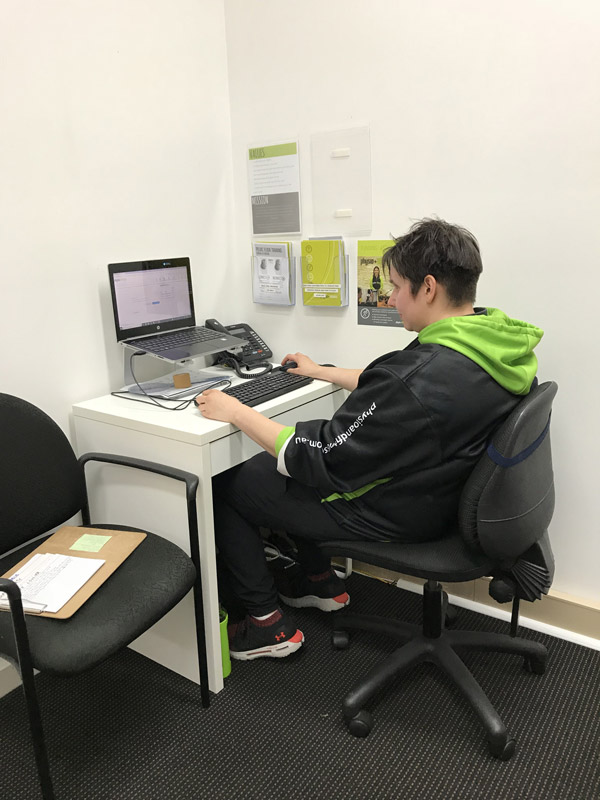Don’t sit up straight!

Should you always sit up straight?
Wait…what?
Don’t slouch, sit up straight! Isn’t that what your Mum would always say?
What if I told you, there was no such thing as one ideal posture for your back? I bet that sounds pretty good to a lot of you who feel like you are constantly straining your back when you force yourself to sit in the conventionally upright position – particularly if you’re working at a desk all day!
I can feel the collective head shakes from all the Mums, as I slouch at the computer writing this. Okay…I never said slouching was good for you either, BUT, it may not be worse for you than actively straining to sit up straight all day. In fact, a relaxed posture, NOT a slouched posture, is less likely to result in back pain than sitting up straight all day.
What happens if you don’t sit properly?
A perfect posture would put minimal strain on muscles, ligaments and joints. That’s all well and good for a short period of time, except when we force our muscles to sustain one static position, they start to work harder and end up straining to maintain that position.
How to sit up straight at work
It’s not a perfect world and you have to work at a desk all day, so what is the best posture?
Well, the best posture is your NEXT posture! Catchy phrase, isn’t it?
This simply means get up, move and change positions. At least every 30 minutes, we should be standing up and having a short stroll before we sit back down again. That’s probably about as often as you find yourself slouching and remind yourself to sit up straight, yet again! This little walk doesn’t have to be far, or long, we just need to hit the rest button to give our backs a chance.
Can’t sit up straight?
While sitting up straight is often emphasised as a good posture habit, it may not always be the best option for everyone in every situation. Here are several reasons why sitting up straight may not be ideal:
1. Individual Differences: The ideal sitting posture can vary from person to person due to differences in body structure, spinal curves, and musculoskeletal health. What works for one individual may not be suitable or comfortable for another.
2. Spinal Curves: The spine naturally has three curves: inward curve (lordosis) in the neck, outward curve (kyphosis) in the upper back, and inward curve (lordosis) in the lower back. Maintaining a rigid, upright posture can flatten these natural curves, leading to discomfort and strain.
3. Muscular Fatigue: Sitting up straight for prolonged periods can cause muscular fatigue as it requires continuous muscle activation to maintain an upright posture. This can lead to muscle tension, stiffness, and discomfort.
4. Flexibility and Mobility: Some individuals have limited flexibility or mobility due to various factors such as age, injury, or certain medical conditions. Forcing a rigid upright posture may be challenging or even painful for these individuals.
5. Ergonomics and Support: Depending on the chair design and ergonomics, sitting up straight may not provide adequate support or alignment for the spine. Backrests with lumbar support or reclined positions can offer better comfort and reduce stress on the spine.
6. Dynamic Posture: The human body is designed for movement, and maintaining a static upright posture for extended periods can restrict blood flow and increase the risk of musculoskeletal issues. Incorporating regular postural changes and movement breaks is essential for overall well-being.
7. Contextual Factors: In certain activities or situations, such as playing musical instruments, typing on a keyboard, or engaging in focused tasks, a slight forward lean or reclined posture may be more suitable for optimal performance and reduced strain.
8. Body Awareness: For some individuals, focusing too much on sitting up straight can create excessive self-consciousness and tension, leading to increased discomfort and stress.
It’s important to note that while sitting up straight may not always be the optimal posture, maintaining a balanced and relaxed posture is generally beneficial. It’s recommended to listen to your body, practice good posture habits, and make adjustments as needed to support comfort and well-being.
Remember, if you have specific concerns about your posture or experience pain or discomfort while sitting, it’s advisable to consult with a healthcare professional or ergonomic specialist who can provide personalised guidance based on your individual needs and circumstances.
Okay, that’s enough for now, my back hurts. I’m off for a stroll.
Hopefully this has been a good reminder that instead of trying to maintain any one posture, we should be striving to AVOID prolonged postures, or at least a good reminder to call your Mum. Make sure you say “Hi!” from me.
Adhesive Capsulitis or Frozen Shoulder: Causes, the stages, prognosis and treatment options
Understanding why it happens, its natural progression and the best ways to manage it, including the role of physiotherapy and potential surgical options. Frozen shoulder, or adhesive capsulitis, is a frustrating condition that can significantly affect your shoulder...
The Physio’s Exercise Guide for Perimenopause & Menopause
Support your body through perimenopause and menopause with effective strength, balance, and flexibility exercises designed to ease symptoms and build resilience.Regular exercise is important for all times of life including as our hormones are fluctuating with this...
To Stretch, or Not to Stretch – That is the Question
Does stretching reduce the risk of injury?Hello again team! Welcome back to another physio word vomit! On today’s menu, we are going to explore the concepts of stretching; is it good for us, do we have to do it, and will it reduce injury risk? Now - this is a bit of...



